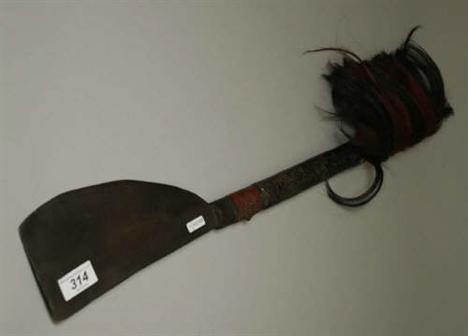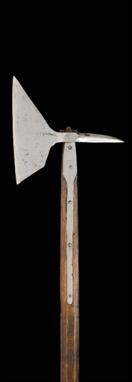A South African Axe, the 34cm slender spatula shaped iron head with recurving tang, slotting through the bulbous heel of the cylindrical haft, bound with bands of woven brass wire, 64cm; a smaller axe, the narrow spatula shaped blade with punched decoration, on a dark and light banded wood haft, 34cm (2)
14783 Preisdatenbank Los(e) gefunden, die Ihrer Suche entsprechen
14783 Lose gefunden, die zu Ihrer Suche passen. Abonnieren Sie die Preisdatenbank, um sofortigen Zugriff auf alle Dienstleistungen der Preisdatenbank zu haben.
Preisdatenbank abonnieren- Liste
- Galerie
-
14783 Los(e)/Seite
A South-East African Axe, the heel to the wood shaft carved as a stylised antelope head, with incised mouth and nostrils, and with brass disc set eyes, with incised straight horns (one damaged), the narrow shaped blade issuing from the body, 44cm; a Similar Axe, carved with bands of chevrons (blade missing); a South African Axe, the narrow recurving blade issuing from the chevron carved rounded cylindrical heel of the ebony shaft, 51cm; a South African Axe, with small crescent shaped blade, the ebony shaft set with a bone disc to each side of the head, carved and stained red with circular and cross motifs, with bone butt, 45cm (4)
An African axe, the wooden haft 31" with 8" crescent blade on 4" tang; a knobkerry style walking stick, 45" overall with small ball handle; a wooden club with tapered swollen head; a bamboo walking stick/club, with cord bound ball handle; an African agricultural axe; another modern African axe; a short spear; and a walking stick covered with woven cane decorated with glass beads. Average GC. (8)
Rare collection of 1930s British Union of Fascists militaria comprising black shirt with high collar and side buttons (size 40), black leather belt with plated buckle with Fascist axe badge, the leatherwork with Sir Oswald Mosley pen signature, BUF stamp and owners name, five BUF lapel badges, book - My Struggle by Adolf Hitler inscribed To Arthus Arthur Olorenshaw-Woods 1937 1st Div British Union of Fascists and National Socialists (8) (Arthur Olorenshaw-Woods joined the BUF in 1937 at the age of 17 when the war broke in 1939 he joined the army and relinquished his membership)
A quantity of Britains etc Repainted Civilian Figures. Including seated figures various types, farm hands, milkman, shepherd, man with pick axe, clergyman, city gent, farmer's wife, various 1920 style ladies, assorted benches, barrel on trolley etc. Also includes a Race Game with lead horses, riders and race-course board. QGC-GC, many well repainted, some wear and chipping to original paint examples.
A Zulu knobkerry, 26" overall, with large spherical head, the haft decorated with bands of woven iron and brass wire (some wear); the wooden stock and trigger action only of a native crossbow; a curious African pipe with bamboo stem and wire bound decoration; the long wooden stem of another pipe; and a reproduction iron axe head on a later wooden haft. Average GC (5)
A 40 BORE INDIAN COMBINED MATCHLOCK PISTOL AND AXE, EARLY 19TH CENTURY, with two-stage barrel fitted with a pair of ramrod-pipes beneath, integral pan (pivot-cover missing), standing back-sight, the breech extending to a faceted moulded neck, and small axe-blade with crescentic head (patinated overall), 39cm; 15 3/8in
A SWISS POL-AXE, LATE 16TH CENTURY, with very slightly curved axe-blade formed with diagonal back- edges of differing length, and robust rear spike stamped with a mark on each side, on an early wooden haft fitted with two pairs of straps (the lower portion of the haft replaced), 22.5cm; 8 7/8in head, Provenance, The Bodmer Collection, Schloss Kyburg, circa 1920, The mark is probably that of Balthasar Erhardt of Zurich. Another pol-axe by this maker is preserved in the Schweizerisches Landesmuseum. See J. A. Meier 1982, pp. 232-234.
A RARE GERMAN GOTHIC POL-AXE, SECOND HALF OF THE 15TH CENTURY, with moulded head drawn-out to four prongs, stamped with a mark on each side at the top (indistinct, one prong chipped), slightly down-curved robust rear spike chiselled at the base with a pair of petal-like mouldings, the head fitted with a stout transverse spike on each side and central blade of flattened-diamond section (areas of light pitting, the blade and one spike possibly associated), a pair of long broad straps, on a later faceted wooden haft studded over the greater parts of its surface with fluted brass studs and six stylised bees arranged in two groups, 44cm; 17 3/8in head, Provenance, Schloss Erbach, Odenwald, Sold Galerie Fischer, 1932, lot 23, Two related examples are preserved in the Deutsche Historisches Museum, Berlin. See H. Müller and H. Kölling 1990, no. 116, 117.
A RARE GERMAN ETCHED HALBERD, DATED 1566, with medially-ridged leaf-shaped central blade etched on the respective faces with the figure of St George on one side and an inscription including the date and the initials P W on the other, all against a stippled ground surrounded by scrolling leafy tendrils, small axe-blade pierced with five holes, rear fluke formed with an additional lug above, the latter stamped with a clover leaf mark on one side, etched throughout with further tendrils inhabited by exotic birds (the etching worn), and faceted socket decorated en suite, on an early fabric-covered wooden haft, fitted with two pairs of straps on the upper portion and the lower encased with a trellis pattern of leather studded with large domed brass nails, 46.2cm; 18 1/4in head, Provenance, Schloss Grafenegg, sold Galerie Fischer, Zurich 1934, lot 47, The inscription reads:, "Gott Mein Trost, Aber Jesus Christus Hat Mich von Allen Suenden Erloest, Anno Domini 1566", A halberd of similar form struck with the same maker's mark and decorated with the Crucifixion on one side and a standard bearer on the other is preserved in the Royal Armouries, Leeds. See C. J. Ffoulkes 1915, p. 248. No. 1026.
A RARE ETCHED HALBERD FOR THE GUARD OF THE PRINCE ELECTORS OF SAXE-WEIMAR EISENACH, MID-16TH CENTURY, with broad central leaf-shaped blade of hollow-diamond section, notched at the base, small crescentic axe-blade, bifurcated rear fluke incorporating an up-turned lug, finely etched over much of its surface on each side with scrolling foliage on a stippled ground, with the full crested arms highlighted in gold on the central blade, and an exotic bird on each side at the base (light wear), a pair of straps, on a later wooden haft, 60.2cm; 23 3/4in head
A STYRIAN HALBERD, LAST QUARTER OF THE 16TH CENTURY, with very long tapering central spike of diamond-section, curved forward-leaning axe-blade pierced with three groups of holes and stamped with a crescent on each face, triangular rear spike pierced with three circles and stamped with a maker's mark, tapering socket, and a pair of long straps (areas of pitting throughout), on a later wooden haft with an additional pair of steel straps, 97.8cm; 38 1/2in head, A number of similar examples are preserved in the Landeszeughaus Graz.
A GERMAN HALBERD, LATE 16TH CENTURY, with two-stage central spike of diamond-section over the upper portion, forward-leaning axe-blade pierced with a slipped trefoil, rear spike with a short up-turned lug at the top, pierced en suite with the axe-blade and stamped with a mark on one side, three crosses within a trefoil, tapering socket, and a pair of long straps (pitted throughout), on a later wooden haft, 46.5cm; 18 1/4in head
A GERMAN HALBERD, LATE 16TH CENTURY, STYRIAN, with tapering central spike, small axe-blade pierced with three groups of holes and stamped with a pair of crescentic marks on each side, rear spike stamped with three pellet marks, a pair of short straps, on a later wooden haft, 34.2cm; 13 1/2in head
A FINE SWISS HALBERD OF SO-CALLED SEMPACH TYPE, THIRD QUARTER OF THE 17TH CENTURY, PROBABLY ZURICH, with reinforced central spike, long slightly curved axe-blade, triangular rear fluke stamped with a double lily mark on one side, and a pair of long straps, on an early wooden haft incised with the letters HR at the top (worm damage), 31.5cm; 12 3/8in head, Provenance, The Bodmer Collection, Schloss Kyburg, circa 1920, The mark is that of Lamprecht or Lambert Koller. Similar halberds struck with this mark are preserved in the Schweizerisches Landesmuseum, Zurich. See J. A. Meier 1982 nos. 16 and 17.
A RARE BAVARIAN SWORD HALBERD, SECOND QUARTER OF THE 17TH CENTURY, with slightly curved sword blade swelling to a double-edged point and cut with a long slender fuller along the back-edge on each side, curved axe-blade, tapering socket with bevelled edges, a pair of long straps, on an early wooden haft with an additional pair of straps, 109cm; 43in head, Provenance, Galerie Fischer, Zurich, 7/8th May 1935, lot 30, Another halberd from this group is preserved in the Czech Republic Army Museum, Prague. See J.Sach 1999, p. 110. Another, formerly in the Collection of His Royal Highness Archduke Eugen preserved in the Armoury at Schloss Hohenwerfen was sold Anderson Galleries, New York 1927, lot 1107.
A GERMAN HALBERD, 17TH CENTURY , with broad leaf-shaped blade, recurved axe-blade formed with a forward-leaning upper tip (cut-down from a larger blade), down-curved rear spike stamped with a mark, conical socket, and a pair of short straps, on a later wooden haft studded with domed brass nails, 38cm; 15in head
A SO-CALLED HEADSMAN'S AXE AND FOUR CHINESE SWORDS, 19TH CENTURY, the first with curved blade and long faceted socket, on a short wooden haft; the swords with flat blades, three with disc-guards and ring pommels and one with cap pommel (rusted throughout), the first: 24cm; 9 1/2in head, (5),
A 19th Indian Silver Gilt Overlay Iron Axe, with crescent shaped head, on a triple collared cylindrical haft all over chased with tendrils and leaves, the bud pommel unscrewing to reveal a knife.. **Together with a hand written label dated 1977 and stating "Found by General Pattle at the Battle of Assaye. He was my gt.gt.grandfather
A Malayan Biliong (Axe), the head with square tang secured to the wooden haft by woven leather mortice which allows for use as either an axe or an adze, with leaf carved decoration and wicker bound handle; a South African Axe, with small head and long narrow spike set through the wood haft with chip carved slightly swollen finial (2)
-
14783 Los(e)/Seite




































